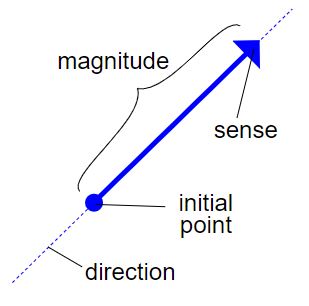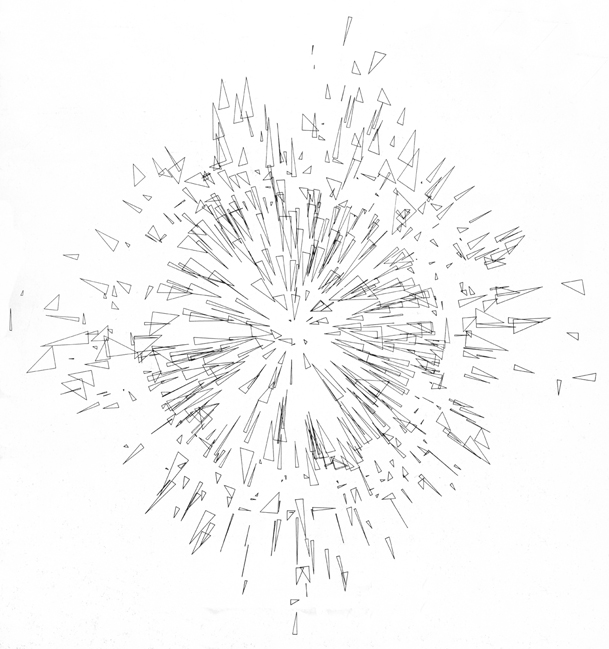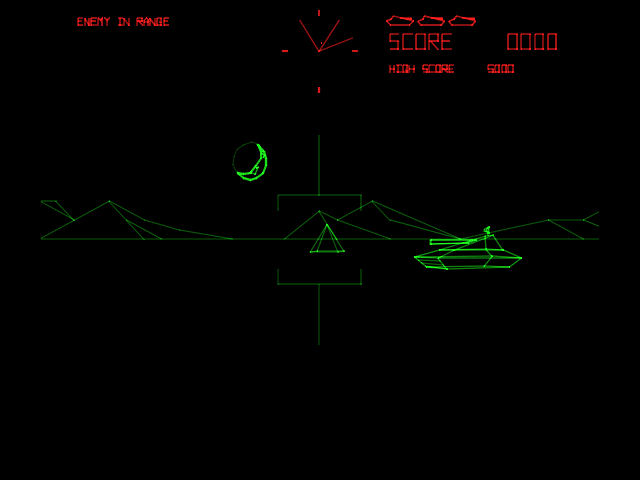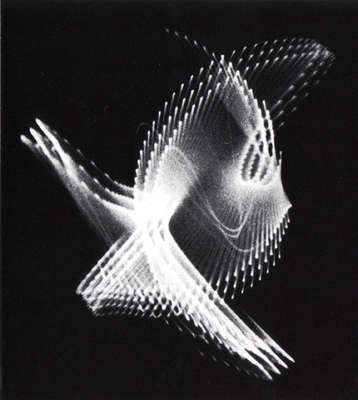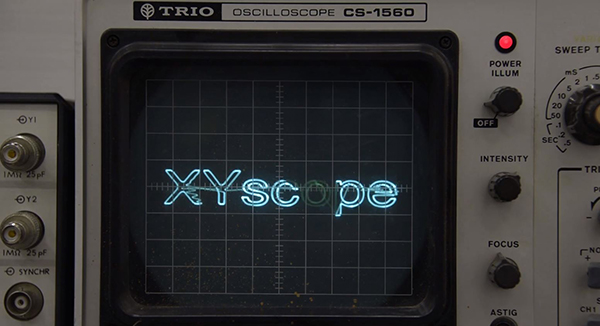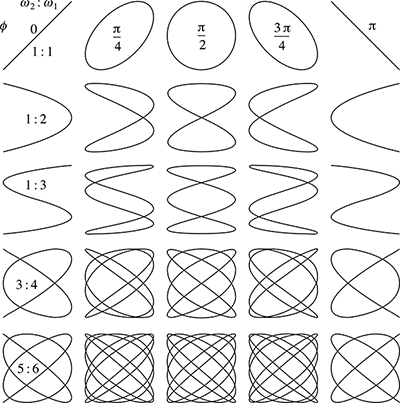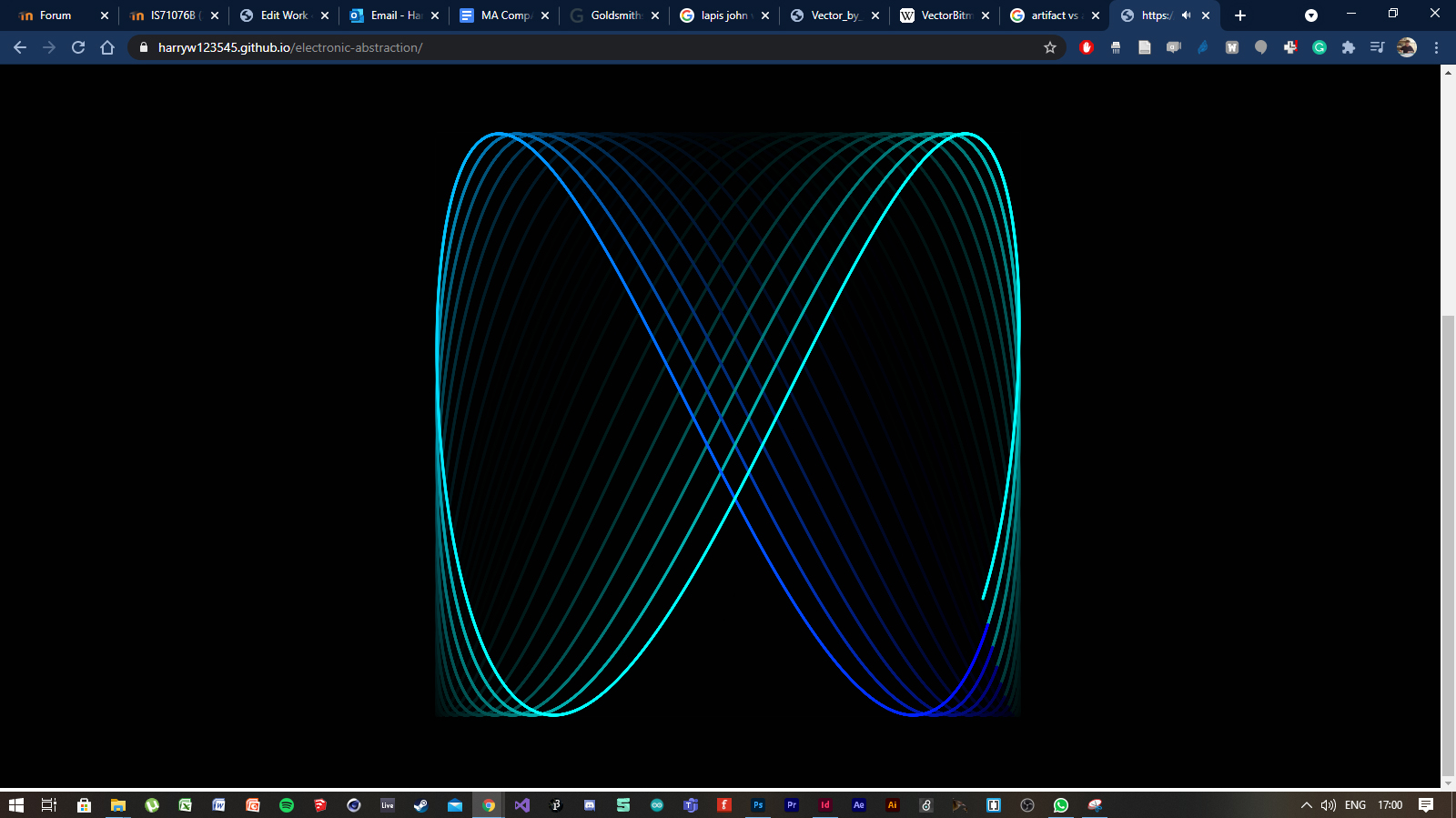A Study Into Media Archaeology & The History Of Computational Art
produced by: Harry Wakeling
Preface
The following essay is a collection of research that I have conducted over the last few months into the history of computer artwork and the field of media archaeology. It contains a series of case studies looking at influential examples of computational art, as well as modern pieces that explore a hybrid approach between old and new media. I would like to thank Dr Mattia Paganelli and Mrs Batool El Dasouky Abdalla for their advice and support on this project. I would also like to thank the members of the Vector Synthesis Facebook group, as well as Chris King, Ted Davis and Derek Holzer for lending their time to conduct interviews with me.
Introduction
My intention for this project is to provide a concise overview on the history of computer artwork and communication technology, as well as studying how and why modern artists choose to create work that utilises a mixture of old and new media. Before I studied at Goldsmiths, I worked as a graphic designer and motion graphics animator. I created computer animations and vector graphics every day, however prior to undertaking this research topic I never considered the origins of these mediums. I felt it would be beneficial and insightful for other practitioners if I were to provide a concise introduction to the history of this field, reflecting on how this has influenced modern computational art.
The main theoretical framework that has guided this project has been the field of Media Archaeology. This involves studying technological developments throughout history and reflecting on how they have shaped the tools we use today. It also involves studying how social and economic principles from a specific time can determine innovation by “digging into how technologies work, and finding structures of power through a technological analysis” (Parikka, 2012). Introduction I have explored this idea within my research, looking specifically at how military technology has influenced computer artwork, particularly during World War II and the Cold War. This has involved looking at early examples of computer animation and vector graphics that originated from technology developed by the military, for example the work of John and James Whitney as well as the SAGE defence system.
During the initial phase of research for this project, I learned that there is a trope within media archaeology that all technological innovation behind computer artwork and telecommunications came from the military industry. I have attempted to address the truth in this statement by examining a series of case studies related to this theme. I am also interested in ascertaining the role artistic creativity has in relation to technological innovation. Another fundamental aspect of my research has involved looking at contemporary artwork that takes influence from media archaeology, exploring a hybrid approach between old and new technology. My research has consisted of studying academic texts and talks, as well as a series of interviews with the researchers Derek Holzer, Chris King and Ted Davis. This has also culminated in an artefact I have created in P5JS inspired by the piece ‘Electronic Abstraction’ by Ben F Laposky, arguably one of the first examples of computer artwork.
John & James Whitney
John Whitney and his brother James are often regarded as the fathers of computer animation. In the late 1950’s, John developed a machine that enabled him to explore his interests in achieving a harmonious relationship between music and visual art. It was developed from re-purposed “anti-aircraft specialized analogue ballistic problem solver computers” (Holzer, 2020) dating back to World War II. Whitney was able to harness the calculated, predictable control of this technology and use it to create a new form of computer animation:
“He transformed this military-spec surplus into a machine for creating experimental animation, literally and metaphorically retooling a device that had itself served to remake human vision for modern war” (Patterson, 2009).
The technology developed by John enabled his brother to create the 1966 film Lapis, described as “the most elaborate example of a mandala in cinema” (Patterson, 2009). The piece begins with a blank field of light, before gradually being filled with a ring made up of thousands of tiny dots. Other patterns then flash into view, such as snowflakes, diamonds and star-bursts, before vanishing. Watching the film trains your eye in the same way that the director of the anti-aircraft computer might have to look; you are scanning a very large expanse of film and recognising patterns, in the same way the director would scan the sky to detect enemy aircraft: “The formal properties of this mandala emerge in dialogue with the apparatus used to create it” (Patterson, 2009). Once you recognise it, you attempt figure out what is happening, however the patterns continuously flicker out of view with no hierarchical arrangement.
Figure 1: Lapis, John Whitney (1966)
Sage
Vector graphics originate from a list of geometric equations that define the image. As a result of this, they can be scaled to any size without losing quality. This operates in contrast to raster graphics that are created using a predetermined grid of pixels. Their amount is set, resulting in a loss of quality when the size is changed.
Figure 2: The difference between a vector and a raster graphic.
In computer animation, we use something referred to as ‘Euclidean vectors’. These are objects that include three important calculations: it’s current location, the angle in which it is headed, and its magnitude.
Figure 3: An example of Euclidean vectors.
This has its origins in the cold war, with a system of computers known as the Semi-Automatic Ground Environment (SAGE). This is considered by researchers to be the starting point of modern computer displays and vector graphics. The intention was to track potential enemy aircraft, referred to as ‘blips’, in order to intercept them with missiles. The ways in which we refer to a missile are essentially identical to the calculations behind Euclidean vectors; studying the origins of SAGE reveals the military thinking behind this technology. It was also one of the first devices used to create a vector for digital artistic expression; a representation of a Playboy pinup girl was created as a test screen for the SAGE display terminals, regarded as one of the first examples of vector artwork. In terms of computing, SAGE has also proven to be extremely influential for a number of reasons:
“Sage development pioneered the fields of magnetic core memory, video displays, light guns, graphic display techniques, simulation techniques, and computer networking via telephone connections” (Holzer, 2020).
Military Splatter Plotters
In 1963, the trade journal ‘Computers and Automation’ launched the world’s first computational arts contest. Submissions were invited for any design or drawing produced using a computer, with the winnings pieces being created by the United States Army Ballistic Research Laboratories. The first prize went to ‘Splatter Plotter’, a scientific diagram of tangential distortion patterns in a camera lens. As it was a visual representation of mathematical phenomena, it was not originally produced for aesthetic or artistic purposes. Despite this, the piece was deemed beautiful by the editors of Computers and Automation and it was published as art:
“The fact remains that technologies working for government-funded military agencies created the first computer-generated imagery deemed to be fine art objects. An analysis of the entries in Computer and Automation dating from 1963 to 1965 reveals that large research laboratories associated with the military dominated computer art production” (Taylor, 2014).
Figure 4: Splatter Plotter, 1963, United States Government, Ballistic Research Laboratories.
The Oscilloscope
An oscilloscope is an instrument used to measure and display the properties of electronic signals. The amplitude, frequency, or other parameters of an electric signal can be displayed on the (usually small) screen of an oscilloscope, normally for test purposes. Before computers were able to store enough memory to enable smooth full colour displays, the oscilloscope served as the “primary device for real-time visual output from the computer” (Reas, 2010).
Figure 5: An example of an early oscilloscope.
They were also used to display some of the first ever video games, such as the 3D first-person shooter ‘Battlezone’. The graphics were drawn with vector lines by displacing beams of light; this allowed for a significantly higher resolution compared to the raster graphics at the time, albeit with a lack of colour.
Figure 6: Battlezone on a vector display.
The oscilloscope was also used to create some of the first examples of computer artwork, in particular the series ‘Electronic Abstraction’ by Ben F. Laposky. In the 1950’s, Laposky used a cathode ray oscilloscope with sine wave generators to create abstract art. He achieved this by tinkering with the electronic beams displayed by the oscilloscope, photographing them using a high-speed camera; the resulting images displayed various aesthetic combinations of basic electronic waveforms that produced a visual response from the sound frequencies being fed into it.
Figure 7: Laposky – Oscillon No. 4 (Electronic Abstraction).
He is often referred to as the original computer artist, making “the first attempts to dissolve the boundary between art and science objects” (Taylor, 2014). The truth behind this statement is slightly more nuanced however. Computer art as a term did not originate until a decade after Electronic Abstraction was exhibited, and Laposky himself associated his work more with kinetic and op art rather than computer art. Despite this, one cannot ignore the importance of Laposky and the way he explored the aesthetic appeal of electronic devices, particularly in the way he created patterns intentionally inspired by natural forms.
The Influence Of The Military
In the pieces previously discussed, I demonstrated how a great deal of computer and vector artwork originated from military purposes. But is it correct to assume that the military has been the only influence in regards to computer art and communication technology? This was a question I posed in a series of interviews as part of my primary research. In a discussion I conducted with the researcher Chris King, he made the following statement:
“The military-industrial complex is a big factor, and it’s easy to claim that all these technologies result from the military, but it’s almost always more complicated than that. Although technologies are often put to use in war, there are loads of other reasons that certain technologies are more successful and emerge, and people design things. Even if they are used in war, that’s not necessarily the whole story. Be careful about stating absolutes, because that is not good academic process; it’s easy to say that it all comes from discarded military hardware, but that’s not the whole story.”
This point was also mentioned in my discussion with the artist and researcher Ted Davis; he stated that aside from the military, pornography has also been one of the driving forces behind telecommunications:
“The driving force being communication technology has been a mixture of the military and pornography. Porn was the leading developer for sending video, audio and compression across the internet. There are so many technologies that have originated in order to deliver that, and the money behind it, that’s where the economics were to create better compression.”
Davis also mentioned the photograph of Lenna, a Playboy pinup girl that was the first scanned image; this subsequently became a standard for image testing.
Figure 8: Lenna, one of the most widely used test images.
This is reminiscent of the aforementioned SAGE defence system and how the users created a graphic also based on a Playboy pinup girl; this was likely one of the first vector graphics created for aesthetic purposes. The aforementioned examples have raised a host of debates around gender issues, in particular how computing and the military have often been associated as predominately male fields.
Davis also mentioned scientific research as a driving factor behind innovation. An example of this can be found in the development of the Braun tube, which formed the basis of the oscilloscope. It was created in order to measure different scientific phenomena, later becoming adapted for the military; this led to innovations that we are still profiting from today:
“Oscilloscopes existed before the military was using them. It had other purposes first, but then a lot of the higher, more capable technology that we are depending on today came out of there. Who can afford to pay for it? Who can pay to research it? The military. It is not the only realm or domain where this technology came from however”.
In summary, based on the aforementioned examples and the points raised by Chris and Ted, I believe it is safe to state that the military plays a huge role in innovation, but not the only role. The real picture is far more nuanced than a lot of tropes within media archaeology would suggest.
Contemporary Work
One of the other main topics I am interested in exploring is how contemporary artists take influence from media archaeology. This is something I have explored within my own work; I have always been interested in the history of moving image, creating artwork that utilises a mixture of old and new technology. I believe there is an interesting dialogue to be explored from merging tools used in early computer art alongside modern developments in areas such as machine learning and computer vision. This allows the artist to reinvent old technology in new and interesting ways:
“A lot of the archaeological methodology has demonstrated the ability to rethink the past in new ways and in new temporalities, as well as considering the futures of media and media change” (Parikka, 2012).
An excellent example of this is the XY Scope library developed by Ted Davis. This project essentially allows the user to take graphics created in Processing and convert them into audio signals, enabling them to display their creations on an oscilloscope.
During my conversation with Ted Davis, we discussed the origins of the library and his inspirations behind creating it:
“Before I worked with oscilloscopes, I was experimenting with pen plotters and other line drawing devices such as lasers. I was also inspired by the work of Just Van Rossum and his project ‘Drawbot’. He created typography on the oscilloscope; he was interested in hearing what typography sounded like, getting different sounds from fonts and serifs. Once I figured out how to send the horizontal and vertical coordinates of my graphics into the left and right audio channels, I could code anything”.
Figure 9: An example of the library enabling the user to display typography.
I also asked Ted about the appeal of working with a CRT screen, as opposed to modern pixel based displays:
“You’re working with lines, dots and points. Our screens are beautiful for looking at photographs and certain types of graphics, but if we are drawing with geometry or playing with lines it’s kind of a shame that we have to view it with pixels and soft edges around it. The vectors are being sampled down to whatever the resolution the screen is. Compare this to an oscilloscope, it’s kind of infinite because it’s somewhere in that space moving the beam from left to right; it’s not a precise position, so there are infinite steps between those points that are in some ways a higher resolution depending on what you are drawing”.
He went on to elaborate about the appeal for artists merging new and old media:
“I like to think that there’s so much power in older media; every media used to be new, and we can still talk to it and pull things out of it that we couldn’t at the time. When the oscilloscope was created there were only certain things that we could do with it, but now with newer programming means we can do all kinds of other things.”
The power of the library lies in the ability to easily implement it into other existing work. This opens up the possibility of using it within areas such as computer vision, using techniques such as outline recognition, blob tracking and Kinect data. It also allows for “generative geometric of typographic shapes to be visualized in the oscilloscope or CRT screen” (Holzer, 2020).
Artefact
For my artefact, I intended to create a piece inspired by early examples of computer artwork, particularly the aforementioned piece ‘Electronic Abstraction’ by Ben F Laposky. You can view the piece here: www.ectronicabstraction.com
I was particularly interested in creating a piece that allowed the user to modulate sound that affected lissajous figures. They are synonymous with early computer art as they were the first shapes to be created on oscilloscopes for artistic purposes. Laposky was particularly interested in experimenting with these patterns in order to replicate forms commonly found in nature:
“In the twentieth century, the lissajous figure became popular as a schema for design, effectively making a shift from the purely scientific to the cultural” (Taylor, 2014).
They are a visual representation of harmonic motion. They are also important as they show the relationship between two periodic signals; the difference in frequency and phase. Lissajous figures were often used to tune the frequencies of electronic equipment, and were later used to test for “phase problems in the stereo image of audio signals for broadcasting and vinyl mastering purposes” (Holzer, 2020).
Figure 10: A table of lissajous figures.
I felt it was important for the user to modulate sound frequencies that affected the form of the lissajous figure, showing how Laposky and other practitioners originally created these forms on an oscilloscope. I was also interested in using this process alongside modern tools that would enable me to easily share the piece on the internet. Using my knowledge in P5JS, I coded a web app that allows the user to modulate sound frequencies, in return creating a visual output on the screen that also changes colour depending on the movements of the user’s mouse. If you fed the sounds from this sketch into an oscilloscope it would also create lissajous figures, as the sketch produces two separate sound signals.
Figure 11: An example of the web app in the browser.
Conclusion
With this research project, I intended to ascertain the role the artist plays in innovation regarding fields such as computer animation and communication technology. I was also interested in looking at historical examples within this field, providing an introduction to a practitioner interested in learning about the history of the medium.
Learning about media archaeology has given my research interests a contextual framing that was previously missing. Through my study on the history of computer artwork and communication technology, I came to learn about fields that have led its innovation, for example the military, science and the pornographic industry.
This led me to question a common trope within media archaeology that all technological innovation originally came from the military. Through primary and secondary research, I learned that while it is true to say this has played a huge role, the field at large is far more nuanced.
So, upon reflection of the points raised in this essay, what does artistic creativity have to offer in terms of technological innovation? While it is true that certain industries like science and the military propel this field, I believe the role of the artist is still very important. Within the context of media archaeology the artist is essential, as they enable the development and re-imagining of certain technologies that otherwise would have been rendered obsolete:
“The job of media theory is to enable: to extract from what is and how things are done ideas concerning what remains undone and new ways of doing it” (Parikka, 2012).
This is an idea that was prevalent in my historical case studies, for example the work of John and James Whitney and the way they re-purposed discarded military technology. It is also evident in the modern examples I examined, such as how Ted Davis was able to use XY Scope to breathe new life into the oscilloscope.
The combination of old and new technology allows for an interesting dialogue by rethinking the past in new ways; in essence, this process establishes media archaeology as an innovative discipline that re-contextualizes old media, making considerations as to where it can go in the future.
Bibliography
Patterson, Zabet (2009) From the Gun Controller to the Mandala: The Cybernetic Cinema of John and James Whitney. [Online]. Available at: https://www-jstor-org.gold.idm.oclc.org/stable/20627774?seq=1#metadata_info_tab_contents (Accessed: 05/04/2021).
Reas, Casey (2010) Form+code in design, art, and architecture, New York: Princeton Architectural Press. ISBN: 9781568989372
Parikka, Jussi (2012) What is media archaeology?, Cambridge: Polity. ISBN: 9780745650258
Taylor, Grant D (2014) When the machine made art : the troubled history of computer art, 8 edn: Bloomsbury Academic. ISBN: 9781623567958
Weibel, Peter (1992) Eigenwelt der Apparate-Welt : pioneers of electronic art, Linz: The Vasulkas, Inc.
Smirnov, Andrei (2013) Sound in Z : experiments in sound and electronic music in early 20th-century Russia, London: Koenig Books. ISBN: 9783865607065
Holzer, Derek (2020) Vector Synthesis: a media archaeological investigation into sound modulated light, 1 edn. ISBN: 9789529422210
Figures
Figure 1: Formoso, C., 2021. Lapis, James Whitney (1966). Available at: <https://www.youtube.com/watch?v=kzniaKxMr2g&ab_channel=Chapad%C3%A3odoFormoso> [Accessed 10 March 2021].
Figure 2: 2021. The difference between a vector and a raster graphic.. [image] Available at: <https://en.wikipedia.org/wiki/Vector_graphics> [Accessed 2 February 2021].
Figure 3: 2021. An example of Euclidean vectors.. [image] Available at: <https://enacademic.com/dic.nsf/enwiki/20007> [Accessed 12 April 2021].
Figure 4: D Taylor, G., n.d. Splatter Plotter, 1963, United States Government, Ballistic Research Laboratories.. [image] Available at: <https://csalateral.org/original/issue2/theory/taylor/index.html> [Accessed 6 April 2021].
Figure 5: n.d. An example of an early oscilloscope.. [image] Available at: <https://www.semanticscholar.org/paper/Oscillons%3A-Electronic-Abstractions-Laposkycae961d8500b3645235dc25703c4213baa67c090> [Accessed 4 April 2021].
Figure 6: n.d. Battlezone on a vector display.. [image] Available at: <https://syltefar.com/game/?id=1517> [Accessed 11 March 2021].
Figure 7: n.d. Laposky – Oscillon No. 4 (Electronic Abstraction).. [image] Available at: <http://dada.compart-bremen.de/item/artwork/215> [Accessed 2 April 2021].
Figure 8: 2001. Lenna, one of the most widely used test images.. [image] Available at: <http://www.lenna.org/> [Accessed 17 March 2021].
Figure 9: Davis, T., 2019. An example of the library enabling the user to display typography.. [image] Available at: <https://teddavis.org/xyscope/> [Accessed 7 April 2021].
Figure 10: n.d. A table of lissajous figures.. [image] Available at: <http://www.met.reading.ac.uk/pplato2/h-flap/phys5_1.html> [Accessed 9 April 2021].
Figure 11: Wakeling, H., 2021. An example of the web app in the browser.. [image] Available at: <https://harryw123545.github.io/electronic-abstraction/> [Accessed 12 April 2021].

































































